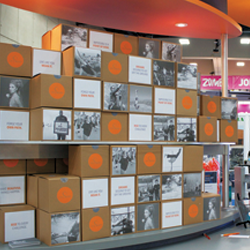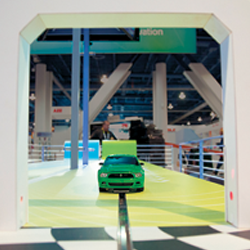|
case study

PHOTOS: Eset North America LLC
EXHIBIT DOWNSIZING:
The Power of Two To increase its return on investment, Eset North America LLC replaces a big, old booth with two 10-by-20-foot in-line exhibits, triples the number
of trade shows it attends, and collects nearly 700 percent more leads. By Charles Pappas
In 2013, senior program events manager Kristen Hinsberger was handed a daunting goal by her company's management team: increase the number of shows on Eset North America LLC's exhibiting calendar, and attract an average of 50 percent more qualified leads at shows where Eset already had an established exhibit-marketing presence. To top it all off, she was asked to accomplish both of those objectives without any increase in her trade show budget. "The pressure was enormous," says Hinsberger. "It seemed impossible."
Historically, Eset, a pioneer in the field of Internet security software, appeared at two heavyweight cyber-security-related shows every year – the RSA Conference and Interop Las Vegas – erecting a 30-by-30-foot exhibit, and typically amassing a healthy haul of 200 to 300 qualified leads per show. Even though the company ranked seventh in the worldwide market for anti-virus software, according to research by software maker Opswat Inc., its brand awareness was substantially lower than competitors such as Symantec Corp., McAfee Inc., and Trend Micro Inc., whose names were synonymous with malware defense. Moreover, since Eset management wanted to significantly expand the firm's revenues and brand awareness in other markets, the company had begun branching out into a variety of new industries, including the health care, education, and finance sectors, which it felt represented a potential bonanza. Indeed, according to statistics from Grand View Research Inc., cyber security in the health-care industry alone will become a lucrative potential market of about $11 billion by 2022. Still, the sound business sense behind the company's edict didn't diminish the sheer difficulty of the task Hinsberger faced. She'd need to identify and vet potential new shows, retool her exhibit-marketing efforts to attract significantly more leads, and find a way to foot the bill for the newly enlarged trade show calendar, as well as the promotional power it would take to affect the change. With the clock ticking, her situation might have appeared to be, in a nutshell, "Mission: Impossible." Hinsberger's approach to it, though, proved as crafty, cunning, and comprehensive as the protective software her company sells. In a series of steps that carefully attacked the colossal tasks she was handed, Hinsberger meticulously broke down the challenge into its constituent parts and thereby rendered it manageable. 
First, Hinsberger and her staff scanned dozens of shows, searching for certain criteria that her past experience suggested might indicate potential success. Specifically, her team looked for shows where information technology (IT) directors made up at least 30 percent of attendees – a kind of tipping point at which events in the past had proven lucrative, since the directors exercised considerable buying power. "We've always wanted to be at every show where security is a big topic, of course," Hinsberger says. "But now we wanted to also be at shows where security is emerging as a hot topic." These new shows, then, offered a chance to crack new markets, like the aforementioned health-care and finance industries, which Eset perceived were the tinder fueling the increases in global spending on information security from $77 billion in 2015 to $101 billion by 2018, per research from Gartner Inc. After several weeks of intense data collection, Hinsberger and her staff identified a handful of shows that fit the bill with a healthy portion of IT managers and an existing or escalating focus on digital security issues, including the Healthcare Information and Management Systems Society (HIMSS) show and the Educause Annual Conference (an IT event focusing on higher education) with a respective 51 percent and 60 percent of attendees hailing from IT departments. The roster of new shows also included VMworld, a cloud-computing meeting, and the Black Hat USA conference, where hackers mingle alongside representatives from corporations and government agencies. 
Having decided which shows Eset would appear at, Hinsberger next needed to choose what the company would exhibit with: its 900-square-foot property that had been used for several years, or some new configuration demonstrating its outreach to new shows and industries. But, after selecting the expanded slate of shows, a new problem cropped up. Some of the slated events ran concurrently or butted up against one another, making it impossible for the company to exhibit at them all. To solve that problem, Hinsberger worked with Czarnowski Display Services Inc., ultimately deciding to retire the old island exhibit and instead build two smaller in-line booths, each measuring 10-by-20 feet. A duo of booths could help the company cover overlapping events on its expanded roster of shows. Furthermore, by storing one in Czarnowski's Orlando, FL, facility (primarily to be used for East Coast shows) and one in its Las Vegas headquarters (for West Coast shows), Eset would avoid cross-country shipping charges while keeping its exhibiting program nimble enough to ebb and flow with the new objectives. And because the new booths were smaller (200 square feet each, versus 900 square feet), the company hoped to score an additional bonus in the form of decreased storage fees for the more modestly sized properties. A drastically reduced footprint – the booths would each be about 80 percent smaller than the previous one – might save money, but that alone wouldn't help Hinsberger score the mandated 50-percent increase in leads that management demanded. However, Eset's decision to replace one big booth with two smaller structures did result in a serendipitous opportunity for the company to give its perhaps flavorless image a makeover. 
Besides shrinking the exhibits' footprints, Hinsberger and Czarnowski added several features to lure Eset's target audience. First, the identical new exhibits would each have a curved profile that would stand out among the uniformly rectangular booths Eset's competitors used. Next, Eset eschewed its mostly all-business approach and substituted a variety of multimedia and interactive elements on which staffers could activate a series of games, loop a variety of informational videos about the company's products, and offer in-depth digital demos. Lastly, the company would install elegant overhead LED lighting to give its booths the visual vibe of an ultra-hip lounge or avant-garde museum. "We wanted the booth to be interactive in a digital and physical way to enhance the visitor experience," Hinsberger says. "There didn't have to be an obvious disconnect between business and entertainment." The Eset Experience "You hit home runs not by chance but by preparation," baseball star Roger Maris said. But whether Hinsberger had done enough groundwork to hit the ball out of the park remained to be seen. The booths' inaugural outings took place during the same week in 2013, at one of Eset's longstanding shows (RSA Conference in San Francisco) and a new addition to its exhibiting calendar (HIMSS in New Orleans). Having properties on both sides of the country allowed Eset the luxury of participating in shows that were close together on the calendar yet far apart on the map. At both shows, the first thing attendees saw when they eyed the Eset exhibit was the new curved silhouette. A row of LEDs set behind a fabric screen imbued each booth with a teal glow like a planet lit by a turquoise sun. When guests continued into the booths, they entered on a light-gray carpet, ornamented with teal and blue swoops, and were greeted by staffers who led them to a 65-inch screen on the right side of the space where a sizzle reel played. 
Once the serious work was finished, guests had an excuse to relax at a 90-inch touchscreen on which they could play up to seven different interactive games, including quizzes, plinko, slot machines, and more. While most games took no more than 30 seconds to play, the quiz entitled "Test Your Security Knowledge" challenged attendees with 15 questions, including ones about which social-media site had its database of 4.6 million usernames and phone numbers pilfered (Snapchat), and what the acronym CYOD means to IT administrators (choose your own device). Once the quiz was over, a leaderboard listed the high scorers, whose names were entered into a daily drawing for prizes, including a MacBook Pro and a quadcopter. 
At the new booths' inaugural shows, Eset collected 35 percent more leads than it expected at RSA, and gathered more than the desired 400 leads at HIMSS. But even more importantly, the dual booths set a pattern of success wildly surpassing the company's goals on a continuing basis. In the last two years, Eset has used the 10-by-20-foot in-lines at nearly 20 shows, producing results that belied the new booths' compact dimensions. Once seen as formidably burdensome, the goal of increasing qualified leads by at least 50 percent now seems as simple as downloading an app. From Black Hat to HIMSS, the company seizes 700 to 1,500 leads per show, an astonishing jump of nearly 700 percent. Not only did the booths generate potentially millions more through the surplus leads, but they also saved the company cash through reduced costs. Even accounting for the upfront investment and ongoing costs of maintaining two booths, the combined storage fees went down 63 percent, and shipping costs decreased 45 percent, compared to the charges incurred by the former 900-square-foot property. Just as malicious code mutates and evolves to safeguard its survival, Eset has tweaked its exhibits to ensure its trade show program's survival, too. For example, over time the company began emphasizing one game more than others at shows, depending on the audience and locale – such as the slot-machine-style game for Interop since the event took place in Las Vegas and the varied IT audience likes to gamble. Recently, Eset also added an interactive boxing game, "Become a Cybersecurity Heavy Hitter," that appeals to the boxing and mixed martial arts fans among other shows' attendees. The exhibits' success has also spurred the company into further expansion for 2016, tacking on new shows in the retail and manufacturing sectors. Eset brags that its software is "The best security money can buy." While on the surface that boast refers to the protection its programs offer customers, the slogan also serves as a reminder of how an exhibiting program, nimbly scaled down and yet smartly expanded, can be the best security a company can invest in to grow its bottom line. E
BEFORE AND AFTER
By trading in its 30-by-30-foot booth for a pair of 10-by-20-foot in-line exhibits, Eset North America LLC was able to triple the number of major shows on the company's annual calendar while simultaneously increasing leads by nearly 700 percent.
|
|
|
||||||||||||||||||||||||||||
|
|
||||||||||||||||||||||||||||
|
TOPICS Measurement & Budgeting Planning & Execution Marketing & Promotion Events & Venues Personal & Career Exhibits & Experiences International Exhibiting Resources for Rookies Research & Resources |
MAGAZINE Subscribe Today! Renew Subscription Update Address Digital Downloads Newsletters Advertise |
FIND-IT Exhibit & Display Producers Products & Services Supplier to Supplier All Companies Compare Get Listed |
EXHIBITORLIVE Sessions Certification Exhibit Hall Exhibit at the Show Registration |
ETRAK Sessions Certification F.A.Q. Registration |
EDUCATION WEEK Overview Sessions Hotel Registration |
CERTIFICATION The Program Steps to Certification Faculty and Staff Enroll in CTSM Submit Quiz Answers My CTSM |
AWARDS Sizzle Awards Exhibit Design Awards Portable/Modular Awards Corporate Event Awards Centers of Excellence |
NEWS Associations/Press Awards Company News International New Products People Shows & Events Venues & Destinations EXHIBITOR News |
||||||||||||||||||||
|
||||||||||||||||||||||||||||






